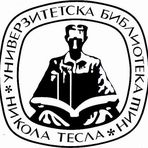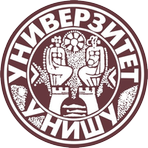Title
Stabilnost i prinudne oscilacije spregnutih nano-struktura
Creator
Stamenković Atanasov, Marija B., 1986-
CONOR:
106342409
Copyright date
2023
Object Links
Select license
Autorstvo-Nekomercijalno-Bez prerade 3.0 Srbija (CC BY-NC-ND 3.0)
License description
Dozvoljavate samo preuzimanje i distribuciju dela, ako/dok se pravilno naznačava ime autora, bez ikakvih promena dela i bez prava komercijalnog korišćenja dela. Ova licenca je najstroža CC licenca. Osnovni opis Licence: http://creativecommons.org/licenses/by-nc-nd/3.0/rs/deed.sr_LATN. Sadržaj ugovora u celini: http://creativecommons.org/licenses/by-nc-nd/3.0/rs/legalcode.sr-Latn
Language
Serbian
Cobiss-ID
Theses Type
Doktorska disertacija
description
Datum odbrane: 4.9.2023.
Other responsibilities
Academic Expertise
Tehničko-tehnološke nauke
University
Univerzitet u Nišu
Faculty
Mašinski fakultet
Group
Katedra za mehaniku
Alternative title
Stability and forced vibration of coupled nano-structures
Publisher
[M. B. Stamenković Atanasov]
Format
[7], 184 str.
description
Biografija autora: str. 183
Bibliografija: str. 165-176
description
Vibration and stability of nano-structures
Abstract (en)
This doctoral dissertation studies the oscillatory behavior of different types of elastically coupled nano-structures comprising two carbon nano-tubes modeled as two nano-beams, two graphene nano-sheets modeled as two nano-plates and a combination of nano-plates and double-curved shallow nano-shells. In the special case of an one nano-structures, the dynamics of a rotating nano-tube are considered. For the mentioned nano-systems, by applying Eringen's non-local stress theory, Euler-Bernoulli's beam theory, Kirchhoff-Love's plate theory, and Novozhilov's linear theory of shallow shells, differential equations are given to describe the vibrations (small transverse displacements) of elastically coupled nano-structures. Analytical and numerical methods are applied to solve the presented differential equations of motion. The stability, free and forced vibrations (damped and undamped) of elastically coupled nano-structures are studied in detail. The dissertation also provides a detailed determination of analytical solutions of eigenfrequencies, transverse displacements due to the action of different types of external loads and critical buckling forces. Analytical solutions and numerical analysis of forced vibrations are presented for the following load types: uniformly distributed continuous harmonic load, concentrated harmonic force, and moving constant and harmonic force. Various parameters that influence the dynamic responses of the upper and lower elements of the presented elastically coupled nano-structures are analyzed in detail. These are: non-local parameter, magnetic field, radius of curvature of a doubly curved shallow nano-shell, damping proportionality coefficients, different values of external loads, hub radius and angular velocity. The investigation into the influence of various material and geometrical parameters is also included in the analyses of critical buckling forces and transverse displacements of damped and undamped vibrations. The objective of the study of these nano-systems is to show that such systems have a damping effect on the amplitudes of vibrations of the nano-system transverse displacements for all observed external loads, due to the increase in the intensity of the magnetic field and the increase in the non-local parameter. The influence of the radius of curvature of the nano-shell, which stems from the nano-plate and nano-shell with an elastically coupled system composed from the two nano-plates, is of great importance. During this analysis of
elastically coupled nano-structures, it is proved that the excited upper element of the nano-system (in this case the nano-plate) has a smaller amplitude of the transverse response vibrations only if the lower element is curved (in this case the nano-shell). In addition to being affected by the decrease in the value of the radius of curvature of the nano-shell and the increase in the value of the non-local parameter, the dynamic absorption or the decrease in the amplitude of the excited upper nano-plate of the presented nano-system is also influenced by the increase in the value of the damping proportionality coefficient and the decrease in the value of the external excitation. The simulation of molecular dynamics for some of the aforementioned elastically coupled nano-structures will be used as a confirmation of the obtained analytical results. The obtained solutions are verified with the results published in international journals.
Authors Key words
Slobodne oscilacije, prinudne oscilacije, stabilnost, nelokalna teorija elastičnosti, spregnute nano-strukture, parametarska analiza, nano-greda, nano-ploča, nano-ljuska
Authors Key words
Free vibrations, Forced vibrations, Stability, Nonlocal theory of elasticity, Coupled nano-structures, Parametric analysis, Nano-beam, Nano-plate, Nano-shell
Classification
531.36 + 539.3]:66.017 - 022.513.2(043.3)
Subject
P190
Type
Tekst
Abstract (en)
This doctoral dissertation studies the oscillatory behavior of different types of elastically coupled nano-structures comprising two carbon nano-tubes modeled as two nano-beams, two graphene nano-sheets modeled as two nano-plates and a combination of nano-plates and double-curved shallow nano-shells. In the special case of an one nano-structures, the dynamics of a rotating nano-tube are considered. For the mentioned nano-systems, by applying Eringen's non-local stress theory, Euler-Bernoulli's beam theory, Kirchhoff-Love's plate theory, and Novozhilov's linear theory of shallow shells, differential equations are given to describe the vibrations (small transverse displacements) of elastically coupled nano-structures. Analytical and numerical methods are applied to solve the presented differential equations of motion. The stability, free and forced vibrations (damped and undamped) of elastically coupled nano-structures are studied in detail. The dissertation also provides a detailed determination of analytical solutions of eigenfrequencies, transverse displacements due to the action of different types of external loads and critical buckling forces. Analytical solutions and numerical analysis of forced vibrations are presented for the following load types: uniformly distributed continuous harmonic load, concentrated harmonic force, and moving constant and harmonic force. Various parameters that influence the dynamic responses of the upper and lower elements of the presented elastically coupled nano-structures are analyzed in detail. These are: non-local parameter, magnetic field, radius of curvature of a doubly curved shallow nano-shell, damping proportionality coefficients, different values of external loads, hub radius and angular velocity. The investigation into the influence of various material and geometrical parameters is also included in the analyses of critical buckling forces and transverse displacements of damped and undamped vibrations. The objective of the study of these nano-systems is to show that such systems have a damping effect on the amplitudes of vibrations of the nano-system transverse displacements for all observed external loads, due to the increase in the intensity of the magnetic field and the increase in the non-local parameter. The influence of the radius of curvature of the nano-shell, which stems from the nano-plate and nano-shell with an elastically coupled system composed from the two nano-plates, is of great importance. During this analysis of
elastically coupled nano-structures, it is proved that the excited upper element of the nano-system (in this case the nano-plate) has a smaller amplitude of the transverse response vibrations only if the lower element is curved (in this case the nano-shell). In addition to being affected by the decrease in the value of the radius of curvature of the nano-shell and the increase in the value of the non-local parameter, the dynamic absorption or the decrease in the amplitude of the excited upper nano-plate of the presented nano-system is also influenced by the increase in the value of the damping proportionality coefficient and the decrease in the value of the external excitation. The simulation of molecular dynamics for some of the aforementioned elastically coupled nano-structures will be used as a confirmation of the obtained analytical results. The obtained solutions are verified with the results published in international journals.
“Data exchange” service offers individual users metadata transfer in several different formats. Citation formats are offered for transfers in texts as for the transfer into internet pages. Citation formats include permanent links that guarantee access to cited sources. For use are commonly structured metadata schemes : Dublin Core xml and ETUB-MS xml, local adaptation of international ETD-MS scheme intended for use in academic documents.


